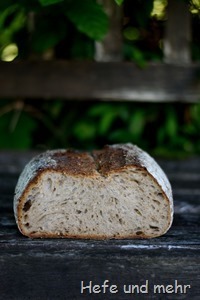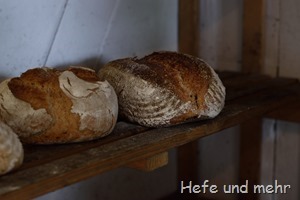 Some breads sneak their way into my my mind and stay there for awhile while my subconscious mind works on the recipe. This time it was a short sentence about a bread MC from Blog Farine tasted in Sandeep Gywalis Bakery: Porridge and roasted buckwheat, filled with many complex flavour notes. There was not much more information but this was enough for my brain to come up with a recipe.
Some breads sneak their way into my my mind and stay there for awhile while my subconscious mind works on the recipe. This time it was a short sentence about a bread MC from Blog Farine tasted in Sandeep Gywalis Bakery: Porridge and roasted buckwheat, filled with many complex flavour notes. There was not much more information but this was enough for my brain to come up with a recipe.
The monthly bread baking day in the local museum Bergneustadt was the perfect opportunity to bake the bread. Because what can make a delicious bread even more delicous? Right – baking it in an old wood fired community oven! And so I roasted the buckwheat the night before and then milled the roasted kernels to a fine, dark brown flour. The smell of the flour was astonishingly delicious: Malty and buckwheaty notes creates a rich and deep flavour. And it was suprising how much water the flour needed when I mixed the sourdough with this flour. The sourdough developed rather strong sour note.
To balance it I added a some maple syrup and to help against the slight destabilizing effect I added some psyllium hulls, too. The dough was then very easy in handling and after baking the bread still had well recognizable smell of buckwheat. It was hart to resist the tempation to rip directly a piece of the bread when it came out from the oven.
But after the bread cooled to a considerable temperature I finally took a bite and was very happy. The bread has a mild flavour, the sourness of the sourdough has vanished into the background. The buckwheat flavour notes are clear and complement nicely the nutty flavour of the oat and the sweetness of the maple syrup. Once again a favourite!
Porridge Bread with roasted Buckwheat
yields 2 Bread
- 100g buckwheat, roasted and milled (see recipe hint)
- 50g rye flour Type 1150
- 210g Water
- 15g sourdough
Porridge
- 100g Porridge
- 200g boiling water
Dough
- sourdough
- Porridge
- 750g wheat flour Type 550
- 360g Water
- 3g psyllium hulls
- 60g maple syrup
- 5g fresh yeast
- 20g Salt
 Mix water, flour and starter for the sourdough and ferment for about 10-12 hours at 28°C.
Mix water, flour and starter for the sourdough and ferment for about 10-12 hours at 28°C.
In the meantime bring water for the porridge to boil, stir in the steel cut oats and cook until it starts to bubble. Remove from heat and keep in fridge till the next morning.
The next morning knead all ingredients 5 min at the slowest speed and 8 min at higher speed until full gluten development.
Let rise for 3 hours, folding the dough three times during this time .
Divide the dough into two parts. Form to long loaves, press a small wooden stick lengthwise down to form a small hinge, then push the loaf back together and and place it in the proofing basket seam side down.
Proof for 1 hour, heat the baking stone at 250°C in the meantime.
Place the breads in the oven with steam. Turn the temperature back to 200°C after 10 min and bake the bread for another 45 min (or bake in a wood fired oven).
Recipe hint: Roast the buckwheat at 160°C for 10-15min. Let cool down and mill to a fine flour.
Deutsch



![Hafergrtz-Brot-mit-gerstetem-Buchwei[2] Hafergrtz-Brot-mit-gerstetem-Buchwei[2]](https://www.hefe-und-mehr.de/wp-content/uploads/2017/06/Hafergrtz-Brot-mit-gerstetem-Buchwei2_thumb.jpg)
Hallo Stefanie,
Habe das Brot gerade aus dem Ofen gezogen, probiert, und bin begeistert, es schmeckt fantastisch! Danke für die gute Idee + Anleitung!
Ich habe eine Frage zum falten. Du sagst, dass bei weichen Teig auf keinen Fall Mehl zugefügt werden darf, um den Teig zu festigen. Aber bei falten geschieht doch genau das.
Was ist der Unterschied zwischen gezielt zugefügten Mehl und dem Mehl, das bei deiner falttechnik in den Teig gerät?
@Claudia: Es ist da auch ein Frage der Menge. Beim Falten kommt nur wenig zusätzliches Mehl in den Teig (oder gar keines, wenn man direkt in der Schüssel faltet, das reduziert auch das Putzen hinterher 😉 ). Wenn man einem zu weichen Teig Mehl hinzufügt sind das schnell 50g oder mehr, und das verändert dann den Teig zu sehr.
Hallo,
da ich beim Aufräumen Buchweizenmehl im Schrank gefunden habe, würde ich gerne dieses Brot einmal ausprobieren (dann halt nicht mit frisch gemahlenem Buchweizen sondern dem fertigen Mehl), ich habe aber keine Flohsamenschalen – kann ich die vielleicht auch einfach weglassen und es einfach so ausprobieren?
@Stefanie: Einfach weglassen ist schlecht, weil dann der Teig sehr weich wird. Ein Kochstück (150g Wasser, 30g Mehl unter rühren aufkochen) würde sich als Alternative anbieten – die Wasser und Mehlmenge dann beim Hauptteig abziehen. Oder du reduzierst die Wassermenge um etwa 30-40g. Und es kann sein, dass der Teig trotzdem etwas schwieriger im Handling ist, da das Buchweizenmehl kein Gluten enthält.
Vielen Dank für die rasche Antwort, ich besorge dann glaub ich mal Flohsamenschalen und probiere es dann aus!
Hallo Stefanie,
ich habe dieses Brot schon einigemale nachgebacken und jedesmal ist es super gelungen. Ich hatte es ein bischen mit Gewuerzen geandert und is ist einer unserer lieblings Brote geworden.
Die Brote sind ganz gut geworden,eins in der Form, Nr 2 ohne,ist aber etwas breitgelaufen.
Vielen Dank für die schnelle Antwort. Der ST blubbert schon schön vor sich hin und ich bin zuversichtlich dass ich morgen zwei schöne Brote aus dem Ofen holen werde. Ich werde berichten.Meine LM hab ich zur Sicherheit auch gleich noch mal aufgefrischt und ich werde dann nach Gefühl einsetzen oder eben nicht.
Hallo Stefanie,habe gerade den Sauerteig für das Brot angesetzt und stell fest ich hab keine Hefe mehr im Haus. Ob ein Löffel LM auch geht oder ich einfach die Stückgare verlängere ??
Gruß aus der Küche, Annett 😉
@Anett: Ein Löffel LM macht jetzt nicht den Riesen-Unterschied, kann aber auch nicht schaden. Und wenn dein Sauerteig schön fit und agil ist, kannst du einfach die Stückgare entsprechend verlängern, dass passt dann schon. Ich hatte hier die Hefe verwendet, da der Holzbackofen halt auf niemanden wartet und ich sicher gehen wollte, dass die Gare passt!
Wann wird die Hafergrütze gemacht? Zeitgleich mit dem Sauerteig?
@Miriram: Ja, danke! Ich habe die fehlende Beschreibung ergänzt!
Hallo, was genau ist Hafergrütze eigentlich? Ich hab heute beim Einkaufen nur Haferkleie gefunden. Ist das das gleiche?
Ich würde das Brot gerne nachbacken, klingt gut und ist mal was ganz anderes.
VG Claudia
Man kann auch Haferflocken nehmen. Kleinblattflocken lösen sich im Brot quasi auf, wenn man eine gröbere Körnung will, kann man Großblatt/grobe Flocken nehmen.
@Fussel: Stimmt schon (diese Variante steht auch in den Kommentaren zu dem verlinkten Brot), damit ändert sich der Charakter des Brotes allerdings schon sehr stark.
@Claudia: Schau mal hier, die Frage kam bei diesem Brot schon mal. Da wurde die Grütze erfolgreich durch Schrot ersetzt 🙂
Vielen Dank für die schnelle Antwort. ☺️
Ich habe das Brot gestern gebacken und ich bin echt begeistert. Ich glaube ich werde beim nächsten mal etwas mehr Buchweizen nehmen.
@Prozek: Das freut mich 🙂 Die Buchweizenmenge würde ich allerdings maximal verdoppeln, da ansonsten es deutlich schwieriger wird, eine stabile Krume zu bekommen (geht auch, wird aber bei einem freigeschobenen Brot dann langsam schwierig)
Das Brot ist mir gut gelungen….Danke für das Rezept…..ich würde beim nächsten Mal allerdings etwas weniger Süsse verwenden.
@Susanne: Das freut mich 🙂 Und die Süße kann man ja gut dem eigenen Geschmack anpassen!